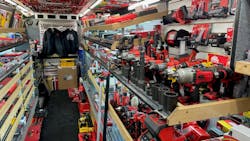So, you went to your annual company/wholesaler trade shows, bought more than you expected, and now the invoices are rolling in. Time to get out there and go sell something!
An interesting thing about our industry is that three of the four major flags start the year off with a sales meeting highlighting the previous year’s successes, the introduction of some new products, and a promotion-packed trade show. The result is that you and your territory competitors are all loaded with significant inventory … and invoices.
So, let’s develop a plan to profitably move more inventory to your current customers and maybe get some new customers too.
Check out the competition
First, check out your competitors’ websites to learn what they are promoting. This will help you understand if any of your newly purchased products are really “new.” Now, answer these questions about those “new” products. Who are the target users of these products? Everybody? Body shops? Front-end technicians?
Now, fire off an email or text to those target users including the literature and a comment or two of your own. Don’t post the price since your competition will surely get the information from one of your customers. A second email/text of the same info four to five days later will keep the product fresh in their minds as you make your sales calls. As you make your calls, be darn sure you carry those products you’re hyping and show them to those target customers.
A side note about carrying in products to think about …
Way back in my Klein Tools (1979) days. as a district manager (salesman), we were introducing a line of really top-notch metal hand toolboxes. For the first week or so I had almost no luck selling them to my distributors. After a lot of “No, thank-you’s,” I realized that I was walking in the door of my customers carrying a bright red metal toolbox instead of my normal sample case. In reality, what I was doing was giving my distributors time to surmise that I was going to try to sell them toolboxes and giving them lots of time to come up with a reason why they didn’t want to stock toolboxes.
Finally, I started carrying the box into my sales calls inside a plain old brown grocery shopping bag. With this tactic, I was able to explain that we were introducing a new product that they were not selling, yet all of their customers used it. This worked perfectly, and we placed a lot of toolbox displays in my electrical distributors’ showrooms.
The same is true for you. If you walk into a customer location openly carrying a new tool of any kind you take away your opportunity to make a great feature, advantage, benefit, close presentation. In plain words, you’re letting the cat out of the bag before you want to.
Carrying on, the email approach I mentioned before will begin to build some interest in your new product, and if this really is a new product, I imagine it is in your current company promotional brochure as well.
Try some retail marketing tactics
Additionally, you may want to use some of the marketing tactics the retailers use so successfully. An email/text to all your customers highlighting that you just returned from your company trade show, and you have excellent levels of your popular products plus many of those hard-to-get items, can go a long way. People still remember all those supply chain product shortages, so use this to your advantage.
Our objective here is to remind your technicians that you are a reliable source for the products they need. You are the jobber they can rely on.
So far, you’re announcing that you have an excellent inventory of cool products for sale that are not on sale. However, sometimes the time comes in business when you need to reduce some inventory and you need to do it quickly. So, think retail.
By advertising that you have some products that are on sale or have excellent pricing, you get your audience’s attention. Secondly, you’re not saying everything is on sale just that some things are.
Start this project with your product spreadsheet. This spreadsheet should show you the quantity on hand, movement, costs, list price, and margins.
Those high-margin, slow-moving products could be your first targets. Discounting some of these slow-moving items, which you have probably already paid for, will free up some cash to help with those pesky trade show invoices.
The next target of your discounting program could be those convenience items like beef jerky or drink mixes. These items should be exceptionally high-margin items to begin with so advertising them at lower prices will also get some attention and create some revenue.
Our objective here is to make some noise in your marketplace because you have excellent inventory and excellent prices. You’re not giving away the store – you’re advertising, you’re marketing, you’re selling.
How many times have you seen a store with the sign out front: BIG SALE!! You walk in the store only to find some selected items up front on sale but most of the products are simply for sale at regular prices. The BIG SALE sign got you in the door, and even if you did or didn’t purchase an item that was on sale, you probably bought some other full-price items. Like when you go into Costco only to get that $4.99 rotisserie chicken and you come out with the chicken, wine, a shirt, and a new 65” TV.
Bring on the merch
One final thought to make some noise in your market. Merch.
I’ve been in the hand tool business since 1977 and absolutely nothing sells tools better than hats and t-shirts. I just checked and you can get ok quality logo’d shirts for less than $5.00 and hats about the same.
Giving away a $5.00 hat on a $200 sale will get you a lot more business than a 10 percent discount and cost you a lot less. A $200 sale at 40 percent gross margin sale will net you $80. Subtract the five dollars for the hat and it’s still $75 in your pocket. Compared to a $200 sale at a 10 percent discount, which the price down to $180 minus the $120 cost and you end up with $60 in your pocket.
Make some noise in your market and … go sell something!
About the Author

Alan Sipe
President, Toolbox Sales and Consulting
Alan W. Sipe has spent the last 42 years in the basic hand tool industry including positions as President of KNIPEX Tools North America, Sr. VP Sales and Marketing at Klein Tools, Manager Special Markets at Stanley Tools and sales management at toolbox manufacturer Waterloo Industries. Currently Sipe is the owner of Toolbox Sales and Consulting specializing in sales strategy, structure, development and training. Sipe can be reached at [email protected] or 847-910-1063. Connect with Sipe on LinkedIn.
